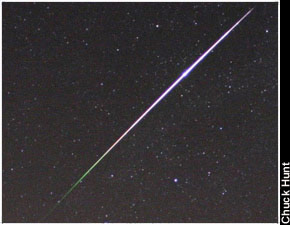 Science
Science
 Astronomy
Astronomy

Home
 Science
Science
 Astronomy
Astronomy

| Contact |
 The Perseid Meteor Shower occurs every summer when the earth passes through the path of Comet Swift-Tuttle, the largest object known to make repeated passes near the Earth. It is named for the constellation Perseus from which it appears to emanate. The Perseid Meteor Shower occurs every summer when the earth passes through the path of Comet Swift-Tuttle, the largest object known to make repeated passes near the Earth. It is named for the constellation Perseus from which it appears to emanate.(Note: Swift-Tuttle has been recorded with a non-zero possibility of impact with the earth, however it's current orbit rules out the possibility of an impact anytime in this millennium. It's nucleus is about 6 miles across, which is roughly equal to the object that wiped out the dinosaurs.) Swift-Tuttle's appearance in 1992 was not spectacular, but the comet did become bright enough to see from many locations with binoculars. The comet passed the earth's orbit in 1991 prior to it's closest approach to the sun (parahelion) in 1992. The 1991 and 1992 meteor showers were exciting with outbursts of 400+ meteors per hour. Even though the comet is out around the orbit of Uranus now the dust particles remain for thousands of years. However, the intensity of the shower will drop off until reappears in 2122. The Perseids are one of the more dependable meteor showers still averaging a shooting star every minute at their peak even 15 years after the comet has passed. The Perseids are probably the most-watched annual meteor shower.
These meteoroids are particles shed from the comet that follow it's orbit around the solar system. They are no bigger than sand grains or pebbles, have the consistency of cigar ash and are consumed many miles above our heads, so you don't have to be worried about getting hit.
Perseid meteoroids are exceptionally fast, entering Earth's atmosphere at roughly 133,200 mph (37 miles per second) causing the long trail. The shower begins, gently, in mid-July when Earth enters the outskirts of a cloud of debris from Comet Swift-Tuttle. The Perseids are considered active from about July 25 through Aug. 18, though hourly rates usually do not rise above 10 until about Aug. 8. Rates fall off much more rapidly after the peak, dropping again to below 10 per hour after about Aug. 14.
Expect 40 to 60 meteors per hour, some of them bright, when it peaks on August 12th, although in any given year concentrated bands of particles may be encountered on the 11th or 13th.
Early morning hours are best, astronomers say, because the part of Earth on which you stand is then facing the oncoming debris as the planet plunges through space on its orbit around the Sun. Experts suggest going out around 2 a.m. and staying until dawn breaks. As Earth rotates, the side facing the direction of its orbit around the Sun tends to scoop up more space debris. This part of the sky is directly overhead at dawn. For this reason, the Perseids and other meteor showers (and also random shooting stars in general) are usually best viewed in the predawn hours. See a Sky Map for Clair Tappaan Lodge / Donner Pass, Soda Springs, CA There might be an extra surge of meteors on August 11th caused by a filament of dust newly (since 1862 passing) drifting across Earth's orbit. Most of the cloud is older (perhaps thousands of years old). Technically, the peak occurs in the afternoon of Aug. 12 in North America. Meteors can only be seen at night, however. The best views will come late Aug. 11 into the early hours of Aug. 12.
Perseid meteors are typically white or yellowish with some glowing trains and an occasional very bright meteor called a fireball.
If you are clouded out on the morning of the 12th, rates on the 13th will also be impressive, much better than those seen the day before maximum. For Europe, the peak comes near or soon after midnight on Aug. 13. (Note: Perseids favor northern latitudes. Because of the way Comet Swift-Tuttle's orbit is tilted, its dust falls on Earth's northern hemisphere. Meteors stream out of the constellation Perseus, which is barely visible south of the equator.) Up to 10 shooting stars per hour not associated with the Perseids grace the sky this time of year. These other meteors can approach from any direction in the sky.
There is a more technical description at the International Meteor Organization 2007 calendar (imo.net) which states: * λ - ecliptic longitude in degrees east from the vernal equinox.
Links and Sources for the above: Return to Don's Home.
|